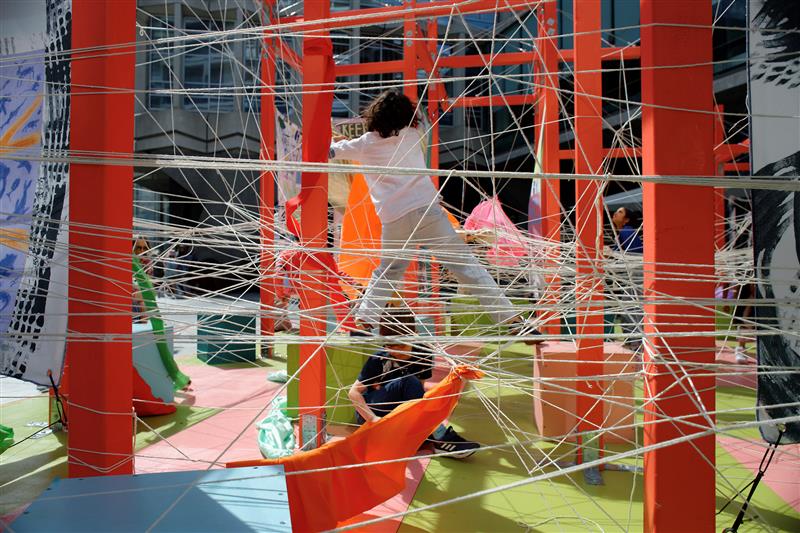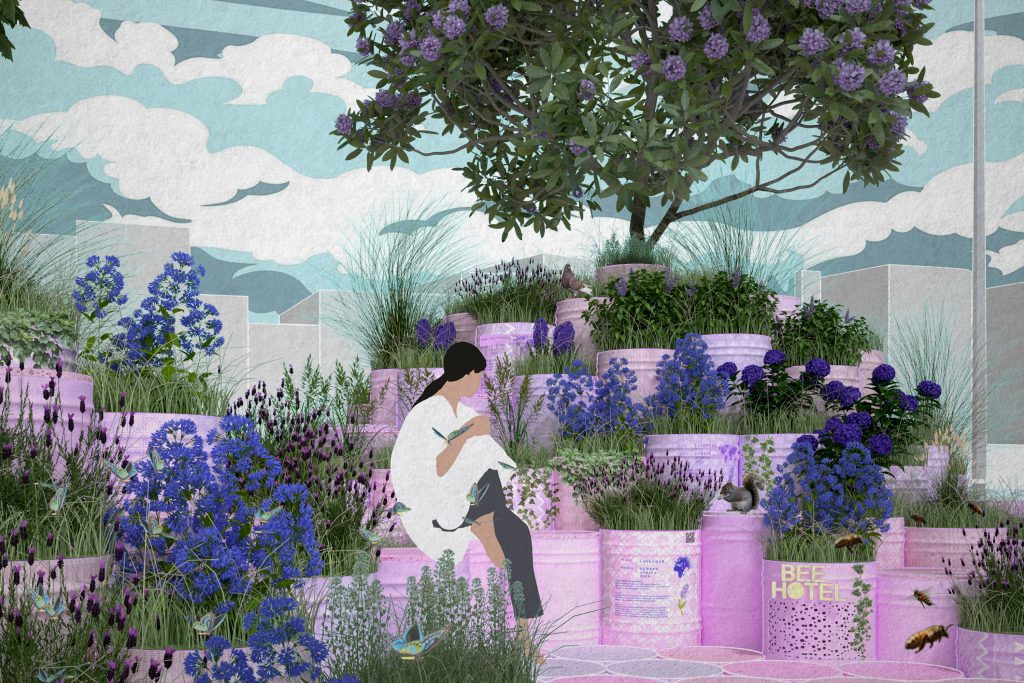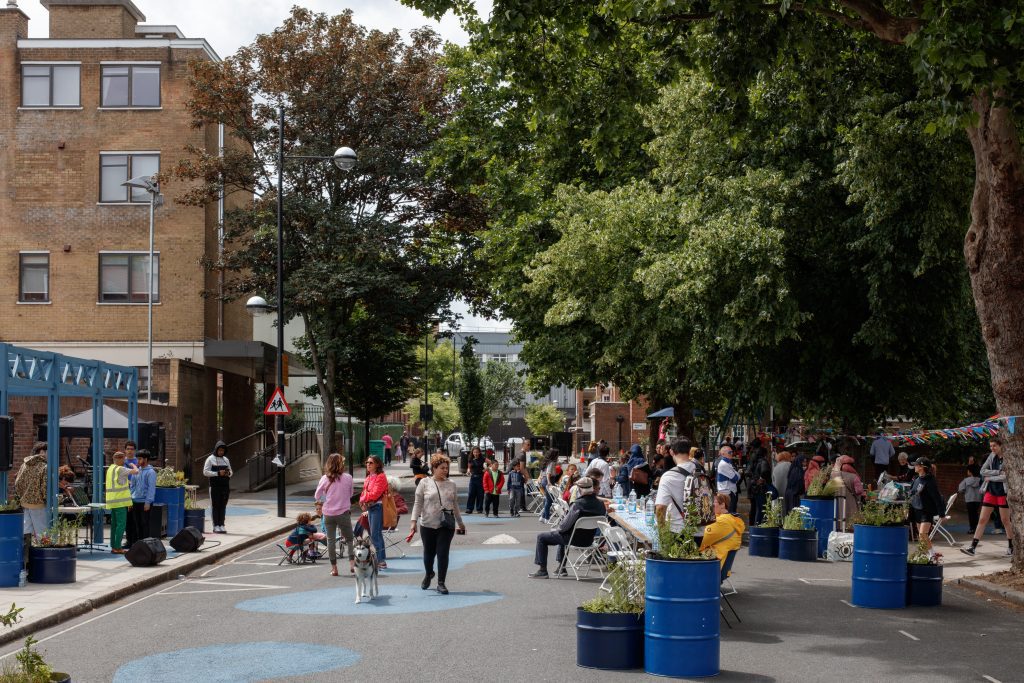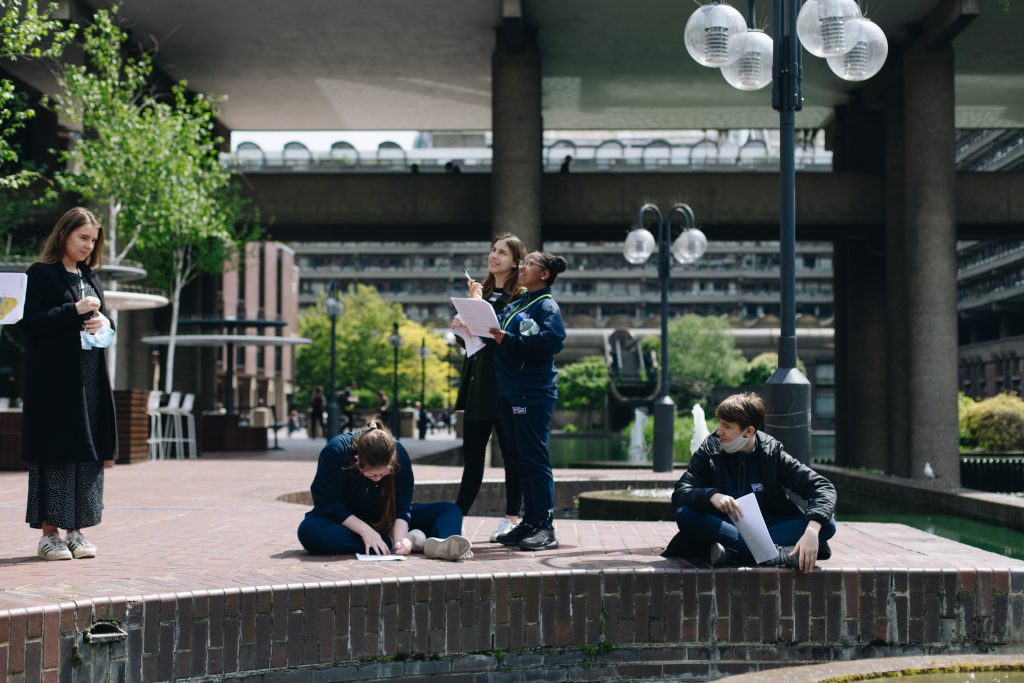Earlier this year, we launched a design competition in collaboration with the Royal Borough of Kensington and Chelsea inviting architects, landscape architects, designers, artists and creatives to reimagine Notting Hill Gate, and contribute to the long term improvements of the area. In keeping with LFA’s mission to harness the talent of London’s architectural and creative community, the aim of the competition was to bring fresh ideas to improving the built environment in this key location, and act as a valuable demonstration project for similar sites across the borough and elsewhere.
The aim of the competition is to commission an innovative and creative public realm intervention that enhances the spaces along the street and encourages people to spend more time in the area. Proposals seek to strengthen the identity of the Notting Hill Gate area as well as align to Kensington and Chelsea priorities for the street such as increased greening and improved wayfinding. The winning team will be encouraged to work with the diverse mix of local residents, business and young people from the area to implement a proposal that is truly reflective of this unique part of London.
This online exhibition includes the six shortlisted concepts that have progressed to the final stage of the competition. These will be on display from the 1st – 30th June in order to gather feedback from the local community and residents that will be used to guide the selection of the winning design team. The winning team will be announced in July 2022 and once appointed, will continue to develop the presented exhibition ideas into a fully costed, feasible design that can be delivered by early 2023.
The competition welcomes community feedback on each of the shortlisted concepts, which can be submitted online by visiting lfa.london/NHGfeedback, via the forms available at the exhibition or using the QR code on the individual boards.
Your feedback will guide our expert panel of competition judges, including Catherine Faulks, Amy Frearson, Sue Harris, Sophia Massey Cook, Anda Winters and Max de Rosee to select the competition winner.
Key Dates
Shortlist exhibition: 22-30 June at Kensington Central Library, 12 Phillimore Walk, London W8 7RX. Opening hours below.
| Monday | 9:30am–8pm |
| Tuesday | 9:30am–8pm |
| Wednesday | 9:30am–5pm |
| Thursday | 9:30am–8pm |
| Friday | 9:30am–5pm |
| Saturday | 9:30am–5pm |
| Sunday | Closed |
Winner announced: July 2022
Installation reveal: Early 2023
Contact Information
If you would like to find out any more information about the project please contact info@londonfestivalofarchitecture.org.
Acts of Activism by Urban Radicals and Afterparti

Our interest in the project comes from a desire to showcase underrepresented narratives within design culture. The site has a history of activism through gathering to protest, which later transformed into gathering for music and performance expressed through Notting Hill Carnival as a way of claiming this part of the city.
Today, the site lacks space for people to gather and for spontaneity to emerge. Like much of the public realm around London, it has come to deter people from lingering through defensive design tools. Our proposal aims to subvert this by proposing a catalogue of objects; seating, pedestals, raised plat- forms, etc. which will be designed to achieve the opposite effect. These will fit into a broader environmental strategy for the street which might help to improve the quality of the street, wellbeing, and greening.
Our process is to undertake a research-based approach to understanding the context by speaking to local interest groups to unearth stories about place, both in its past and current state, followed by design development with a scope for community engagement to develop and test prototypes in sustainable materials, drawing from the site’s past history of potteries and kilns. With our proposal we hope to reveal stories about how this area used to be, bringing back the idea of activism in a subtle way through the introduction of a catalogue of playful, subversive and educational objects.
The project brings together Era Savvides and Nasios Varnavas, architects and co-founders of Urban Radicals, with Marwa El Mubark and Nile Bridgeman, designers, writers and co-founding members of Afterparti.
Urban Radicals is a collaborative architecture and design studio, solving problems across contexts and scales. Their work exemplifies ways of operating outside of traditional office structures, in which architecture is formed slowly and on the periphery through workshops, stories, paintings, parties, dinners, fishing trips, walks, gatherings and conversations.
Afterparti is a collective of architects, curators and writers exploring ideas of equity in the city through the lens of identity and race. Through their self-published zine, critical writing, and built collaborations they are interested in improving representation; and advocating for models where everyone has a right to the city.
The team is supported by Atelier Ten, award-winning environmental design consultants.
The Green Thread by Andre Kong Studio and Wayward

Notting Hill Gate has a rich and vibrant history, layers of cultural heritage, diverse communities, unique perspectives and multi-generational voices. Much is currently hidden away behind closed doors, only brought out for 2 days a year with the carnival. This diverse, local and contemporary history should be celebrated every day of the year and breathe life into the future of the street.
These streets used to be safe, playful, full of family activities. Since the 50s they have become transitory and grey. We want to bring the communities green spaces, their back gardens, into the street – and not just the plant life – we want the colour, the stories, to return the streets to their former glory. The Green Thread will wind it’s way across the high street, stitching it together, connecting neighbourhoods, weaving through the community, connecting people from their back gardens to the street.
A series of verdant installations inspired by multicultural planting full of fragrance and colour combined with playful street games gives new life to grey pavements and creates fun way-finding paths through the new heart to the spaces beyond.
At the core of the project sits the community, helping to grow the project in their own back gardens, really bringing their gardens out into the streets.
Andre Kong Studio was founded in 2016. It was initiated on a part-time basis and has only launched fully in 2021, which in many ways makes it a design start-up.
Set up by the Portuguese-born British architect Andre Sampaio Kong, the design and architecture studio explores how material tradition, context and technological innovation can be unexpectedly combined to alter the way we develop fun and elegant solutions for sustainable and inclusive buildings, objects and experiences.
Wayward is a London-based landscape, art and architecture practice – an award- winning collective of designers, artists and urban growers. Since 2006, Wayward has pioneered new methodologies in the creative use of underutilised land and meanwhile spaces, transforming derelict sites into large-scale, design-driven spaces that engage local communities and inspire international audiences.
Wayward takes a unique approach to landscape through the creation of narrative environments. Our projects express stories that connect people through nature, creating vibrant places which are productive, meaningful and imaginative to create original, engaging and immersive experiences. Our work goes beyond design to extend to creative direction and production, project delivery, strategic partnership building, community engagement, original programming, curation and live events.
Colonnade of Colours by Wood Street Walls, Maich Swift Architects, thinkFOUNDATION, Linett Kamala and Greg Bunbury

Addressing four key sites along Notting Hill Gate, the spaces defined by columns are imagined as civic structures. The colonnaded frames, reminiscent of toll gates, form a buffer between pedestrians and traffic and serve as landmarks. The family of structures make places for gathering and happenstance meetings or could afford more specific functions such as a flower kiosk, bandstand, clock tower, market stall or news stand.
The columns are joined with a colourful frieze depicting local stories, myths, events, installations and important figures, printed onto fabric and stretched over the lightweight timber structures. At night the structures will be illuminated with the timber frames visible through the fabric like a lantern. This surface treatment could be expanded to cover building elevations or filling gaps in the main streets, these can be the location of artist’s projects, murals or temporary signs for the area’s community, arts and other activities. Elemental ‘kit of parts’ construction will allow the structures to be modified, moved or easily recycled. The knock down construction facilitates replacement of frieze panels and a shifting programme of decoration and use, which the local com- munity will be encouraged to use, curate and engage with.
This open infrastructure has the potential to encourage socially equitable spaces reflecting the needs, interests and culture of the local community, enable a lively and changing (and extendable) tapestry of activity, flexible for a wide range of public and community uses, along with lighting installations, projections, street furniture and way finding signage.
Colonnade of Colour is a submission from a collective of a number of creative individuals and practices which includes:
Maich Swift Architects; Paul Maich and Ted Swift, an architectural practice with a strong focus on making characterful, practical and robust projects using environmentally responsible materials and methods of construction.
Greg Bunbury, visual communicator and graphic designer and curator of Black Outdoor Art.
Linett Kamala, an interdisciplinary artist, Founding Director of Lin Kam Art and Board Director of the Notting Hill Carnival Trust.
ThinkFoundation, led by Chris Barrett, providing work experience and education in carpentry for at-risk young people, creating pathways into employment.
Wood Street Walls – London art collective, exploring social engagement and practice primarily through public art and murals.
Re-Green Notting Hill by George King Architects and Grow to Know

Our vision is driven by the power of plants to reconnect people to nature and each other. Our aim is to re-green Notting Hill Gate by installing a series of small, sculpted pocket gardens that together create a new undulating landscape for the community to explore, play, relax and perform.
The design of our gardens draws on the colours, patterns and traditions of the local community. The Notting Hill Carnival and the tradition of upcycling discarded oil drums to create Steel Pans has inspired us to create our gardens entirely from upcycled industrial oil drums. We hope that the transformation of a discarded waste product containing toxic and polluting oil into a beautiful, lush community garden will be an inspiration to help us live more sustainably and sends a powerful message of our need to move beyond oil and other damaging fossil fuels.
The oil drum is the basic module of our gardens and will be transformed for a variety of uses including planters, seating, insect habitat, stages and lighting. They will be brightly painted and decorated with patterns inspired by the eclectic range of goods from around the world found in nearby Portobello Road Market.
Re-greening as an educational tool is at the heart of our design so each garden will include a large number and variety of plants. Each plant will include an infographic providing information about the plant and its cultural significance to the diverse communities of Notting Hill and a QR code which can be scanned to find it in local shops and restaurants.
Our team is a collaboration between two local West London practices who share an ethos and passion for using thoughtful design, horticulture and place-making to create imaginative and inspiring works that bring our communities together, reconnect them with nature and create a positive transformation within our city.
George King Architects work within the disciplines of architecture, art and landscape to create unique works that unites these fields. They have a great deal of experience creating projects in public spaces in the UK and internationally including in Australia, US and Europe. They have a research-based approach to developing their projects that responds to the unique opportunities and challenges of each site. They draw on its natural and built environment, its history, culture, community, people and stories to develop bespoke projects that are imaginative, enduring and sustainable.
Grow2Know’s heart lies in reclaiming space and reconnecting people with nature and each other. Putting community at the forefront in the creation of public, outdoor spaces, Grow2Know is pioneering a model that pivots on consultation, collaboration, and place-making. Building partnerships to activate spaces, the grassroots non-profit is committed to inspiring a culture change to implement more sustainable systems that promote biodiversity, circular economies and regenerative practices. Grow2Know is on a mission to inspire, heal and educate through horticulture – embarking on a journey to make gardening more inclusive and nature accessible to all.
Meet Me at Notting Hill Gate by NOOMA Studio

Notting Hill Gate has a strong history of entertainment and culture. The site hosts the historic Coronet Theatre and Gate Cinema, as well being a short walk from the famous Notting Hill Carnival. We will celebrate this history with a light show that leads you down the street to discover a hub of entertainment.
Notting Hill Gate provides an opportunity to create a green corridor between the neighbouring Holland Park and Kensington Gardens. Pollinators will be invited to travel through the space, stopping at characterful homes in the tree canopies.
Existing infrastructure is utilised throughout this proposal, offering disorientated people and animals a vibrant place to stop and rest with the trees Additions which celebrate and reinvigorate the existing beauty of the street’s character.
NOOMA Studio is an award-winning interdisciplinary practice of architects and creatives with a heartfelt connection to London. We are here to problem solve and create joyful spaces which support human thriving and wellbeing. We create accessible, people-led spaces through investigation, engagement, design, delivery and post occupancy support. NOOMA is founded on diversity and our membership is formed of Londoners from non-traditional backgrounds.
NOOMA Studio is a member of the LHC’s OJEU compliant Architecture and Design Services framework. Accolades include The Architects’ Journal’s 40 under 40 as ‘one of Architecture’s brightest up and coming talents’, The RIBA Journal’s Rising Stars and Archiboo’s Best Newcomer.
Open Up by WR-AP, GB Urban Studio and Francesca Perry

We propose a series of ‘green pockets’ across Notting Hill Gate that will become places of relaxation, leisure, culture, play, and greenery – and which celebrate sustainability and local creativity. One big idea is to replace the old metal railings in the middle of the road running eastwards from the Tube station with planters of bamboo, to add greenery into this traffic-heavy area and help improve air quality. This would continue the 1990s transformation in Notting Hill Gate, where trees replaced railings.
We believe in reducing waste, so want to repurpose these removed metal railings to become new forms of street furniture, combining them with wooden additions to form public seating, high desk, planters, cycle parking, play equipment and even exhibition stands to showcase local culture. Situated in the ‘green pockets’, these transformed railings would be joined by night-time lighting, community murals, more plants, and sustainable public seating made from recycled timber and rubble. We would save some railings and work with the RBKC Youth Council and community members to collaboratively transform them for the wider neighbourhood – in school yards, community centres and gardens.
We understand and support the community’s desire to improve the pedestrian environment, enhance greenery and celebrate local culture – helping Notting Hill Gate become a healthier, greener place which brings people together and invites them to stay.
Together as a team, we are committed to sustainable, participatory architecture that nimbly responds to context and brings joy. WR-AP is an architectural practice based in southwest London, founded in 2018 by Max Rengifo and Sean Weston, after sharing 16 years of professional experience in the UK. Their process emphasises strong community engagement alongside thorough architectural thinking. GB Urban Studio is the practice of Germán Bahamón, a Colombian architect now living and working in Notting Hill Gate. Germán was co-founder of colab-19, a Bogotá-based laboratory of architecture which worked on rapid-response, post-pandemic constructions. Francesca Perry is founder of Thinking City, a platform for inclusive urbanism, and has a background in journalism and participatory urban design across London.






